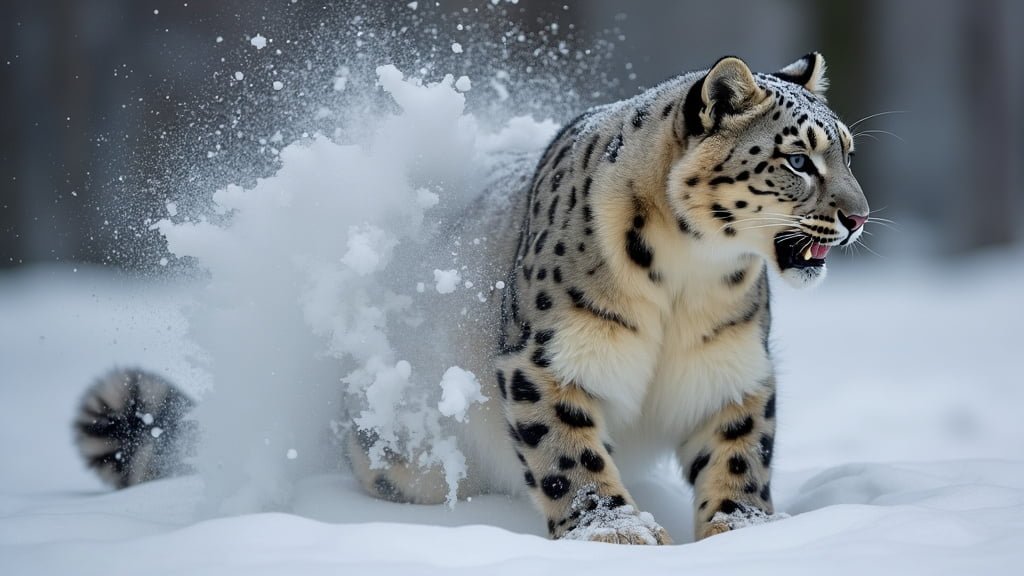Introduction
Snow leopards are remarkable predators adapted to some of the harshest environments on Earth. One of their most fascinating survival strategies is the way they store food for later consumption. This behavior is crucial for surviving the unforgiving winters of their mountainous habitats
In this article, we will explore how snow leopards store their prey, the environments where they perform this behavior, and the impact of food storage on their survival and reproduction. By understanding these strategies, we gain deeper insights into the unique adaptations that allow snow leopards to thrive in the wild
How Do Snow Leopards Store Their Prey?
Snow leopards are solitary predators that inhabit some of the most challenging environments on Earth, primarily in the high-altitude regions of Central and South Asia
Due to the scarcity of prey in these areas and the energy demands of hunting in rugged, snow-covered terrain, snow leopards have developed unique strategies to store food for later consumption. These strategies are essential for their survival, especially during harsh winters when prey is even more difficult to find
Techniques Used by Snow Leopards to Store Food
One of the primary techniques snow leopards use to store food is caching. After successfully hunting a large prey animal, such as a blue sheep, ibex, or argali, the snow leopard will often drag the carcass to a secluded spot
This might be a rocky outcrop, a crevice, or an area with thick vegetation, which provides some natural concealment. To further protect the kill from scavengers like ravens, wolves, and even other snow leopards, they cover it with snow, rocks, or debris
This method of storing food, known as caching, serves several purposes. It helps to preserve the meat by keeping it cool and hidden, reducing the risk of it being discovered by other animals
Additionally, this technique allows the snow leopard to return to the carcass over several days, consuming the stored food at its leisure. This is especially important because the effort involved in hunting large prey is significant, and a successful kill can provide enough food to sustain the leopard for several days or even a week
Types of Prey Snow Leopards Typically Store
Snow leopards primarily target medium to large-sized ungulates, which are herbivorous mammals like sheep and goats, that are well-adapted to mountainous environments. Their most common prey includes species such as blue sheep (bharal), Siberian ibex, Himalayan tahr, and argali. These animals provide a substantial amount of meat, which makes them ideal for caching
In addition to these larger prey animals, snow leopards may also hunt smaller mammals like marmots, hares, and birds when larger prey is not available. However, due to their smaller size, these animals are less likely to be cached and more likely to be consumed immediately
The selection of prey for caching is influenced by several factors, including the size of the prey, the difficulty of the hunt, and the environmental conditions. Larger prey is more likely to be cached because it provides more food, and it can take several days for the snow leopard to consume it fully. In contrast, smaller prey is typically consumed in one feeding session
Duration of Food Storage by Snow Leopards
The duration for which a snow leopard can store its food largely depends on the size of the prey, the environmental conditions, and the presence of scavengers
In cold, snowy environments, where temperatures can drop well below freezing, a cached carcass can remain edible for several days or even weeks. The snow leopard will return to the cache periodically to feed, taking advantage of the natural refrigeration provided by the snow and ice
In contrast, in slightly warmer conditions or during the summer months when temperatures rise, the meat may spoil more quickly, reducing the amount of time the snow leopard can rely on the cache. Additionally, if scavengers discover the cache, the snow leopard may lose its stored food before it has a chance to consume it entirely
Studies have shown that snow leopards can exhibit territorial behavior around their caches, especially in regions where food is particularly scarce. They may stay close to the cached food, guarding it against potential scavengers and other predators
This behavior underscores the importance of food storage in the snow leopard’s survival strategy, particularly in the harsh environments they call home
Environments Where Snow Leopards Store Food
Snow leopards are found in some of the most extreme environments on the planet, where food is often scarce and the terrain is rugged
The way they store food is heavily influenced by the characteristics of these environments. Understanding the habitats where snow leopards live and how these affect their food storage strategies is crucial to understanding their overall survival tactics
Mountainous and Snowy Habitats
Snow leopards primarily inhabit mountainous regions in Central and South Asia, including the Himalayas, the Tibetan Plateau, and the mountains of Mongolia, Russia, and China
These areas are characterized by steep, rocky terrain and are often covered in snow for much of the year. The altitude can range from 9,800 to 16,500 feet (3,000 to 5,000 meters), with some snow leopards even venturing higher
The snow-covered landscapes offer both advantages and challenges for food storage. On one hand, the cold temperatures help preserve the carcasses that snow leopards cache, preventing them from spoiling and allowing the leopard to return to the food over several days. On the other hand, the deep snow and difficult terrain make it challenging for the snow leopard to drag a kill to a suitable caching location
The leopard’s powerful limbs and thick fur, however, are well adapted to these conditions, allowing it to move efficiently through the snow and find or create hiding spots for its food
The Role of Terrain in Food Storage
The rugged terrain of the snow leopard’s habitat plays a crucial role in how and where they store their food. Snow leopards typically cache their prey in areas that are difficult for other animals to access, such as narrow ledges, steep cliffs, and rocky crevices. These locations not only hide the prey from scavengers but also protect it from the elements
Snow leopards are incredibly agile and can navigate steep and rocky landscapes with ease. They often use this ability to their advantage when caching food, choosing locations that are difficult for other predators to reach. The natural camouflage of these areas, combined with the snow leopard’s own ability to blend into the rocky surroundings, makes these caches even more secure
In some cases, snow leopards may cache their food in multiple locations within their territory. This strategy reduces the risk of losing all their stored food if one cache is discovered by scavengers. It also allows the leopard to move around its territory while ensuring it has access to food without needing to make a fresh kill every time
Challenges of Storing Food in Harsh Climates
Despite the advantages of cold, snowy environments for food storage, there are significant challenges as well
One of the main challenges is the constant threat of scavengers. In the mountainous regions where snow leopards live, scavengers like ravens, vultures, wolves, and even other snow leopards are always on the lookout for an easy meal. While snow leopards take great care to hide their caches, the scent of a fresh kill can attract scavengers from miles away
Another challenge is the variability of the climate. While cold temperatures can preserve food, sudden thaws or changes in weather can accelerate the decomposition of cached prey. This is particularly problematic in the spring and early summer when temperatures begin to rise. Snow leopards may need to consume their stored food more quickly during these times or risk losing it to spoilage
The rugged terrain itself can also pose a challenge. While it offers secure hiding places, it can make it difficult for snow leopards to access their caches, especially after heavy snowfall or rockslides. In some cases, a snow leopard may abandon a cache if it becomes too difficult to retrieve
Despite these challenges, the ability to store food in these harsh environments is a crucial survival strategy for snow leopards. It allows them to maximize the benefits of a successful hunt and reduces the frequency with which they need to expend energy on hunting in a landscape where prey is often scarce and difficult to catch
Impact of Food Storage on Snow Leopard Survival
The ability to store food plays a crucial role in the survival of snow leopards, particularly in the harsh and unforgiving environments they inhabit
This strategy not only helps them endure periods when prey is scarce but also influences their reproductive success and overall fitness. Understanding the impact of food storage on their survival offers valuable insights into the ecological adaptations of these elusive predators
Importance of Food Storage in Winter
Winter is an especially challenging time for snow leopards. As temperatures plummet and snow covers the landscape, prey becomes increasingly difficult to find
The animals that snow leopards typically hunt, such as ibex and blue sheep, migrate to lower elevations or become less active, making hunting more challenging. During this time, food storage becomes vital to the snow leopard’s survival
By caching food during times of abundance, snow leopards create a buffer against the scarcity that winter brings. A single large kill, such as a blue sheep, can be stored and consumed over several days or even weeks, reducing the need for frequent hunting
This energy-saving strategy is crucial in an environment where the effort required to make a kill is high, and the risk of failure is significant
Studies have shown that snow leopards tend to cache food more frequently in the winter months, likely as a direct response to the increased difficulty of hunting during this season. By relying on stored food, snow leopards can maintain their energy levels and body condition, which is essential for surviving the long, cold winter months
How Stored Food Helps in Raising Cubs
Food storage is also critical for snow leopards that are raising cubs. Female snow leopards give birth in late spring or early summer, and during the first few months of life, the cubs are entirely dependent on their mother for food. The mother must not only provide for herself but also ensure that her cubs have enough to eat
In this context, food storage becomes a lifeline. After making a kill, a mother snow leopard will often cache the prey in a secure location and return to it repeatedly to feed her cubs. This reduces the need for her to leave her cubs unattended while hunting, which could expose them to danger from other predators or environmental hazards
The ability to store food also allows the mother to manage her energy expenditure more effectively. Hunting is energy-intensive, and by caching food, she can minimize the frequency of hunts, conserving energy for caring for her cubs
This strategy increases the likelihood of cub survival, which is critical for the continuation of the species
Effects of Climate Change on Snow Leopard Food Storage
Climate change poses a significant threat to the habitats of snow leopards, and by extension, to their food storage strategies. Rising temperatures and changing precipitation patterns are altering the ecosystems in which snow leopards live, with potential consequences for both their prey and the snow leopards themselves
As temperatures increase, the snow line in mountainous regions is gradually shifting upward. This could reduce the availability of the snow and cold temperatures that help preserve cached food, leading to faster spoilage
Additionally, changes in vegetation and prey distribution may force snow leopards to hunt more frequently or travel greater distances to find suitable prey, which could reduce the effectiveness of their caching behavior
Moreover, unpredictable weather patterns, such as sudden thaws or unseasonal snowfall, could disrupt the snow leopard’s ability to cache food effectively. For example, a sudden thaw could cause a cached carcass to spoil more quickly, while unseasonal snowfall might make it more difficult to access stored food
Conservation efforts aimed at protecting snow leopards must take these climate-related challenges into account. Understanding how climate change affects snow leopard behavior, including food storage, is essential for developing strategies to support the long-term survival of this iconic species
Conclusion
Snow leopards have adapted remarkable strategies to survive in some of the harshest environments on Earth
Their ability to store food is a crucial part of their survival strategy, allowing them to manage the scarcity of prey in their high-altitude habitats. By caching their kills in secluded, often inaccessible locations, they ensure a steady food supply even when hunting becomes difficult, particularly during the harsh winter months
The environments where snow leopards live—rugged, mountainous, and snow-covered—play a significant role in their food storage practices. The cold climate helps preserve their stored prey, while the challenging terrain provides natural hiding places to protect their caches from scavengers
However, these advantages come with challenges, including the constant threat from scavengers and the potential impacts of climate change, which could disrupt these critical survival tactics
Furthermore, food storage is vital for the survival of snow leopard cubs, as it enables mothers to provide consistent nourishment while minimizing the need for risky hunts. This strategy is not only essential for individual survival but also for the continuation of the species
As climate change continues to alter the snow leopard’s habitat, understanding and supporting these survival strategies will be key to conserving this elusive and endangered predator. Snow leopards’ reliance on food storage highlights the intricate balance they maintain with their environment, a balance that must be preserved to ensure their future in the wild













